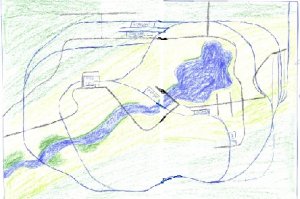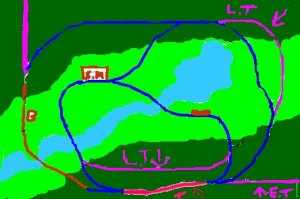Connor-
Welcome to The Gauge. Feel free to ask away here.
Here's my take on your question.
There were very few logging railroads that survived into the diesel era. Those that did generally fit a single mold...a reload center at one end of the line where logs were brought in from the woods by trucks and were re-loaded onto railcars, and the sawmill at the other end of the line. Some logging railroads served more than one reload, but one was the norm.
Here is a quick (possibly incomplete) list of logging railroads that survived and the diesels they purchased. Locomotives purchased new are denoted (N) and locomotives purchased used are denoted (U)
California
Hammond, Samoa, CA- 1 Alco S-1 (N), 1 EMD SW-900 (N)
Pickering, Standard- 4 SW-9's (N)
McCloud River- 1 GE 70-ton (N) plus two Baldwin S-12 switchers leased from the McCloud River Railroad
Pacific Lumber Co., Scotia- 2 Baldwin VO-type switchers (U) and 3 GE 80-ton switchers (N)
Arizona
Southwest Forest Industries, Flaggstaff- 1 Baldwin S-12 (U)
Washington
Weyerhaeuser, Longview- Multiple EMD SW-type switchers, mostly new
Weyerhaeuser, Vail- had 3 Fairbanks-Morse switchers (N), plus an Alco C-415 (N) and a couple GP-7's in later years (U). See Below.
Schafer Brothers, Shelton area- 1 Alco S-1 (N)
Simpson Timber, Shelton- 1 EMD SW-900 (N), 3 EMD SW-1200's (2 N, 1 U), 1 Alco S-2 (U), 1 Alco S-4 (U)
Rayonier, Grays Harbor- 5 Baldwin AS-616's (U)
Rayonier, Sieku- 3 Baldwin S-12's (2 N, 1 U)
Oregon
Coos Bay Lumber Company, Powers- 3 SW-1200's (N)
Brooks-Scanlon, Bend- 2 Alco S-3 (N)
Edward Hines, Seneca- 4 Baldwin AS-616s (U) plus 2 Alco S-3 (U)
Weyerhaeuser Springfield- 4 or 5 GE 70-tonners (U)
Weyerhaeuser Sutherlin- 1 Baldwin S-8 (U) and 1 Whitcomb 80-ton (?)
Weyerhaeuser Klamath Falls- 2 Baldwin S-8 and 2 Baldwin DS-4-4-750's (all N), later replaced with three GP-9's (U)
Medford Corp., Medford, 1 Baldwin S-8 (N)
Idaho
Potlatch, 3 Whitcomb 65-ton centercabs (all N)
British Columbia (Vancouver Island)
Comox/Crown Zellerbach- 1 Baldwin VO-type switcher, later replaced with a pair of Alco RS-type road switchers (all used)
Canadian Forest Products- Woss/Beaver Cove- 4 EMD SW-1200's (3 N, 1 U)
I'm sure I missed some here, and I may have gotten some models slightly off, but this should give you a pretty good idea of what kind of diesels were used in logging. Your "typical" logging locomotive would be a switcher type, usually in the 800-1200 horsepower range, usually either from General Motors-Electro Motive Division (EMD) or from Baldwin. Many of these locomotives had special features not found on most locomotives of the switcher type, such as dynamic brakes and larger fuel tanks, which forced air reservoirs onto the top of the unit hoods.
Here are some links to some pictures of some locomotives specially equipped for logging service, mostly from Rob Jacox's Western Rails website.
Coos Bay Lumber Company EMD SW-1200's, specially equipped with dynamic brakes and roof-mounted air reservoirs:
http://www.trainweb.org/westernrails/or/cblc-1202-ner.jpg
http://www.trainweb.org/westernrails/or/gp_1202_powers_12-29-69_spc.jpg
Weyerhaeuser's Baldwins assigned to their Klamath Falls operations (base of rail operations was at Sycan, OR; logging railroad went 45 miles north from Sycan, and logs were forwarded to the mill at Klamath Falls by the Weyerhaeuser-owned common carrier Oregon California & Eastern). Note the spark arrestors on these units:
http://www.trainweb.org/westernrails/or/wtc_102_sycan_6-79_spcoll.jpg
http://www.trainweb.org/westernrails/or/wtc-101_kfalls_8-19-95.jpg
A whole slew of photographs taken one cold morning at the Sycan shop complex by Jimmy Bryant and posted on his Loggers, Railroads and Pine site"
http://home.att.net/~lassen.logger/wtc-gallery.htm
Be sure to click on all the photos to see the larger images. Both the power for the logging railroad and the power for the Oregon California & Eastern are seen.
Weyerhaeuser EMD GP-9, at Sycan, which replaced the Baldwins:
http://www.trainweb.org/westernrails/or/wtc_311_sycan_spcoll.jpg
Simpson Timber Company's SW-900 and SW-1200's:
http://www.trainweb.org/westernrails/wa/index.html
This is an index page, with LOTS of thumbnails on it. Click on each thumbnail to view a larger image. There are a couple Simpson shots up near the top (the SW-900 and an Alco switcher), but if you scroll down towards the bottom of the page there are five more photos of the EMD's. These units have dynamic brakes (except for the #1202) and normal sized fuel tanks.
Weyerhaeuser Longview roster:
http://www.trainweb.org/cwwr/longview/index.html
Contains roster information and photos for just about every locomotive used on Weyerhaeuser's Longview line. This railroad hauled enormous amounts of timber up until 1980, when the eruption of Mt St. Helens destroyed just about all of the timberlands tributary to this railroad. The railroad remains active today hauling woodchips and rough cut lumber between a couple Weyco mills, but it is no longer a logging railroad.
Weyerhaeuser had an extensive logging railroad operation south and east of Tacoma, centered around the Vail, WA area. I won't go into the entire history here, because it is a long one...so long that a publisher is currently in the process of working on a THREE VOLUME SERIES OF BOOKS about this one operation. Anyway, in addition to the private logging railroad there were a couple common carrier lines that were part of the overall operation- the first was the Chehalis Western, which lasted up until around 1976, when it was replaced by the Curtis Milburne & Eastern, which lasted until 1980. In that year the Chicago Milwaukee St. Paul & Pacific Railroad abandoned their entire mainline from Miles City, MT to Tacoma, which was the largest single railroad abandonment up to that time. Weyco had depended heavily on the Milwaukee for a good portion of it's log movements, and to protect that transportation source Weyerhaeuser purchased roughly 200 miles of track and around 500 log flats from the Milwaukee after it shut down. Weyerhaeuser created a new Chehalis Western to run the railroad, which they equipped with four new GP38-2 diesels purchased new from General Motors, which joined a couple of GP-9's and an Alco C-415 inherited from the previous operations. For pictures of these units, visit Rob Jacox's website about the Chehalis Western at:
http://www.trainweb.org/cwwr/
Potlatch Corp. was also dependent on the Milwaukee to support their operations in St. Maries, Idaho, and as such they purchased around 100 miles of track after the MILW shut down and created a new shortline railroad, the St. Maries River Railroad, to operate that line. The St. Maries was equipped with five locomotives (3 GP-9's, 2 SW-1200's) purchased from the Milwaukee, plus several hundred log flats and a bunch of other equipment.
For motive power, I would suggest looking at either the Athearn EMD SW-7 or SW-1500 or Baldwin S-12. These are good running and good looking locomotives. If you are willing to spend a little more, then I would strongly encourage you to look at any one of the Stewart Baldwin switchers (DS-4-4-1000, VO-660 or VO-1000, S-8, S-12) or one of the Life-Like Proto 2000 switchers (SW-9/1200, SW-8/900, Alco S-1) or one of the Atlas Alco switchers (S-2, S-3, etc.). They are a little bit more expensive than the Athearn locomotives, but they are MUCH better runners and are much more highly detailed. I would recommend getting an undecorated model if you can and creating your own paint scheme- solid yellow or solid orange were common on logging diesels, or something with bright visible colors.
Finally, there are a couple resources you should look at getting. Railroad Model Craftsman magazine did a four part series on Pacific Coast Logging that appeared in the January-April 1984 issues. January issue carried an overview of Pacific Coast logging, including a discussion of different forest types and how that affected the types of logging that went on in each one; February issue was about the steam locomotives used in logging; March was about the equipment used on logging railroads during the steam era; and April was about the diesel era of logging railroads. You will definately want to get your hands on the April issue, and it is worth it to get the other three as well. Walthers a few years ago came out with their "Trees and Trains" series that produced a series of models based on the forest products industries, and they produced a book "Trains, Tracks and Tall Timber" or something close to that. It does contain quite a few mistakes and leaves a lot to be desired, but it is one of the best collections of diesel era logging railroad photos available in any source. There are a couple good books about specific regional areas that contain good information on diesel loggers, specifically Logging By Rail by Robert Turner (about Vancouver Island, B.C.) and Logging to the Salt Chuck by Pete Replinger and John Labbe, which is about the Simpson Timber company and railroad out of Shelton, WA. CTC Board did a seven part series on diesel loggers in the mid- to late-1980's...the seven operations covered were Simpson, Chehalis Western, Canadian Forest Products, Camas Prairie, St. Maries River, Weyerhaeuser Springfield (OR), and Weyerhaeuser Klamath Falls (including the Oregon California & Eastern). I don't have the specific issues at hand right now, but will be able to provide them in about a week if you are interested. There are two magazines out there that are entired devoted to logging railroads, Tall Timber Short Lines (
www.osorail.com) and Timber Times (
www.timbertimes.com). Finally, I recommend that you join the Yahoo 4L e-mail group (Loyal Legion of Logged-on Loggers). It is a good, friendly group.
A good source for back issues of any magazines that I mentioned in Railpub (
www.railpub.com).
I hope you find this interesting, and I apologize for making it this long. I should also put in a plug here for my own website-
http://www.trainweb.org/mccloudrails (McCloud River Lumber Company, McCloud River Railroad Company, McCloud Railway Company). It was a logger up until 1963.
I hope this helps, and if you have any questions just ask away. I will try not to overwhelm you next time.
JD Moore
Elko, NV
http://www.trainweb.org/mccloudrails


